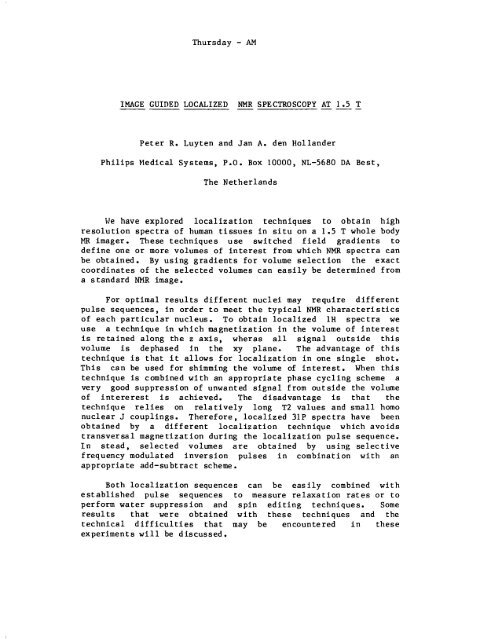th - 1987 - 51st ENC Conference
th - 1987 - 51st ENC Conference
th - 1987 - 51st ENC Conference
You also want an ePaper? Increase the reach of your titles
YUMPU automatically turns print PDFs into web optimized ePapers that Google loves.
Thursday - AM<br />
IMAGE GUIDED LOCALIZED NMR SPECTROSCOPY AT 1.5 T<br />
Peter R. Luyten and Jan A. den Hollander<br />
Philips Medical Systems, P.O. Box I0000, NL-5680 DA Best,<br />
The Ne<strong>th</strong>erlands<br />
We have explored localization techniques to obtain high<br />
resolution spectra of human tissues in situ on a 1.5 T whole body<br />
MR imager. These techniques use switched field gradients to<br />
define one or more volumes of interest from which NMR spectra can<br />
be obtained. By using gradients for volume selection <strong>th</strong>e exact<br />
coordinates of <strong>th</strong>e selected volumes can easily be determined from<br />
a standard NMR image.<br />
For optimal results different nuclei may require different<br />
pulse sequences, in order to meet <strong>th</strong>e typical NMR characteristics<br />
of each particular nucleus. To obtain localized IH spectra we<br />
use a technique in which magnetization in <strong>th</strong>e volume of interest<br />
is retained along <strong>th</strong>e z axis, wheras all signal outside <strong>th</strong>is<br />
volume is dephased in <strong>th</strong>e xy plane. The advantage of <strong>th</strong>is<br />
technique is <strong>th</strong>at it allows for localization in one single shot.<br />
This can be used for shimming <strong>th</strong>e volume of interest. When <strong>th</strong>is<br />
technique is combined wi<strong>th</strong> an appropriate phase cycling scheme a<br />
very good suppression of unwanted signal from outside <strong>th</strong>e volume<br />
of intererest is achieved. The disadvantage is <strong>th</strong>at <strong>th</strong>e<br />
technique relies on relatively long T2 values and small homo<br />
nuclear J couplings. Therefore, localized 31P spectra have been<br />
obtained by a different localization technique which avoids<br />
transversal magnetization during <strong>th</strong>e localization pulse sequence.<br />
In stead, selected volumes are obtained by using selective<br />
frequency modulated inversion pulses in combination wi<strong>th</strong> an<br />
appropriate add-subtract scheme.<br />
Bo<strong>th</strong> localization sequences can be easily combined wi<strong>th</strong><br />
established pulse sequences to measure relaxation rates or to<br />
perform water suppression and spin editing techniques. Some<br />
results <strong>th</strong>at were obtained wi<strong>th</strong> <strong>th</strong>ese techniques and <strong>th</strong>e<br />
technical difficulties <strong>th</strong>at may be encountered in <strong>th</strong>ese<br />
experiments will be discussed.













